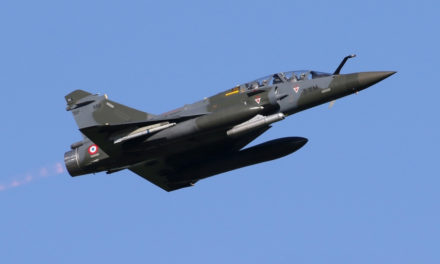
In the first of our 10th anniversary features, Rob Edgcumbe sits down with a true aviation legend.
‘There are many legendary names in the aviation business but one that will always be high on the list is Clay Lacy. Rob Edgcumbe sat down with him for GAR to learn about his many exploits in aviation and the business he continues to run.’
“This was an article I wrote for an edition of Global Aviation Magazine (GAM). The magazine format allowed a different way to present material. It was a fascinating interview because Clay had done so much in his career. I knew he was short of time to talk but he was very generous in sharing stories, showing me artifacts and providing me with a souvenir. When I thought we were done, he then took me for a drive around the airport to another hangar where some of the more historic items were stored. His team were also incredibly helpful in preparing the feature. I have been able to do a ton of fun and interesting things writing for GAR and picking a highlight is tricky but for the variety of material and the historic nature of so much of it, this one was the one that stood out for me.”
Spending time with Clay Lacy is like a condensed version of post war aviation. He is a man who was determined to be an aviator and then followed that determination with getting himself involved in so many aspects of aviation over the years that he seems to have done it all. This presents a problem when trying to write about him. How can I possibly summarise his career in anything less than a large book? Others have actually written books on his life in aviation but I am not trying to do that. Instead, I want to provide enough to give a feeling for the man. I suspect you will then be tempted to do your own research on some or all of his many exploits at a later date.

A young Clay with a Stinson – Clay Lacy Collection

Clay in 1953- Clay Lacy Collection

California ANG F-86s- Clay Lacy Collection
As with all stories, it is probably appropriate to start at the beginning. Clay grew up in Wichita, Kansas and was a young lad as the Second World War was winding down. His Grandmother had a farm across from a golf course on which a guy had stored a number of light aircraft that he had acquired after they were declared surplus by the military. Clay spent time hanging out over there and, when the guy said he was looking for an airfield to start operating from, Clay decided his Grandmother’s farm would provide a great solution.
His skills of persuasion were up to the task and within three weeks, a strip had been cut out of the fields and the planes were flying. His farming career was over! Clay spent as much time there as he could, helping out and getting cockpit time as recompense. As time went by, he spent more and more time flying, often solo. This didn’t go unnoticed – mainly since he was approaching fourteen years old at the time. He was told to get a student’s permit quickly if he wanted to keep flying so he did – the permit was only available to 16 year olds and above so, as far as the FAA was concerned for the next four decades, that’s how old Clay became!
As he explains, “It went all through my career until just before I retired from United. I straightened it out then. When I was coming up on 58, United thought I was 60 and was going to retire! I went and got my licenses changed at the FAA. Then I found out that I wasn’t the only person that had done that. I was about the fourteenth person that had changed their age!”
By the age of sixteen – really sixteen, not whatever age the FAA had – Clay had his instructor’s rating and was clocking up hours at a high rate. The GI Bill was funding pilot training for soldiers back from the war and there were plenty of students for Clay to train. His next step was to get a job with the airlines. At 19 years old, he secured himself a job in the right seat of DC-3s flying for United. He was the youngest first officer they had.

Super Guppy testing- Clay Lacy Collection
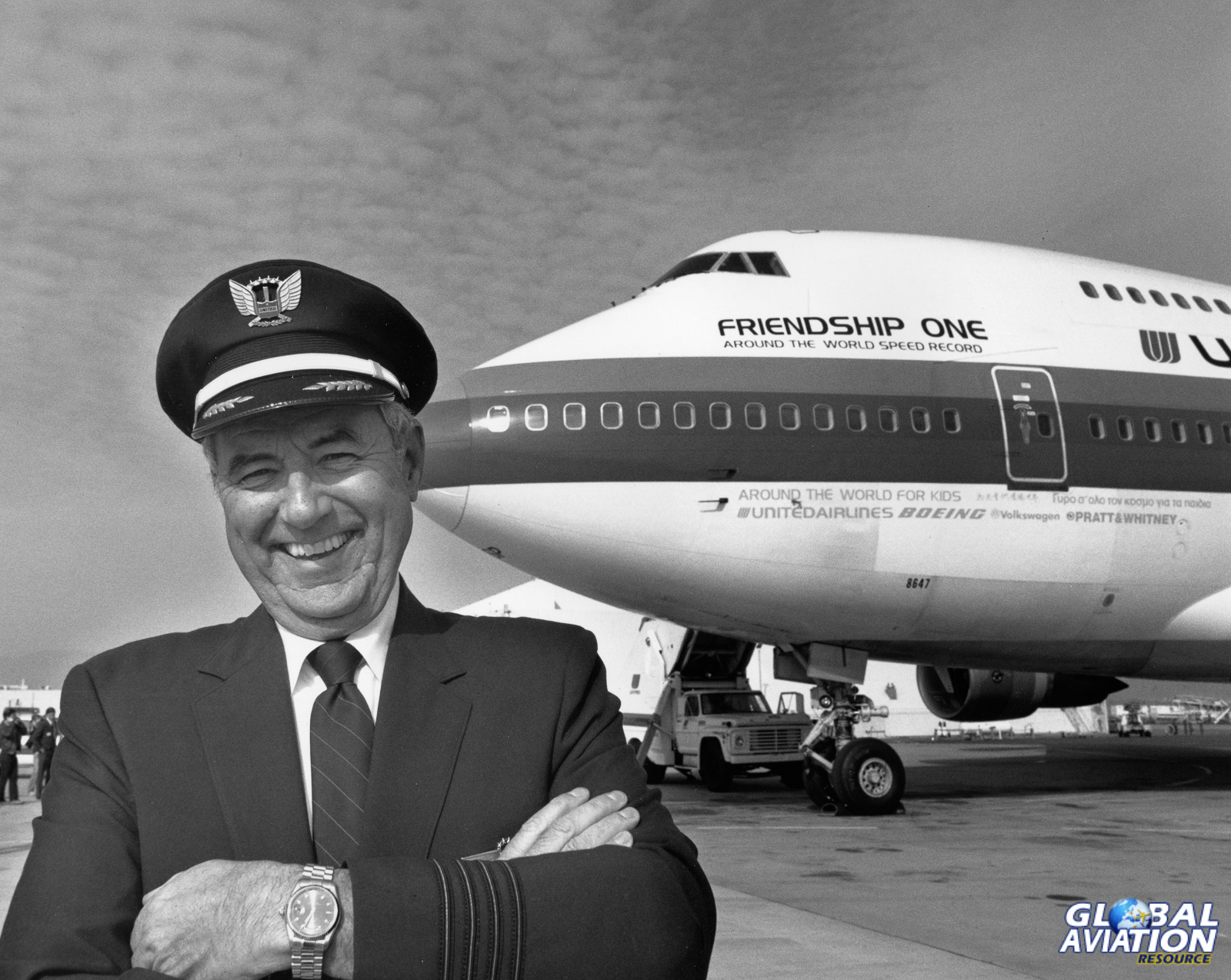
Clay with his round the world 747 – Clay Lacy Collection

Bill Lear, Danny Kay and Clay lock at the mockup of the jet- Clay Lacy Collection
The next question was where he would be posted. “Most new pilots went to New York or Chicago. West Coast was a popular place and you had to work your way out to it. When I graduated flight school, most guys were from New York or Chicago and wanted to go back so I had my choice. I came to LA and have always stayed here.” He was occasional operating from other locations but these were basically commutes from his Los Angeles base.
Two years in to his time with United and another flying opportunity presented itself. The draft board still existed at that time so Clay decided a good solution would be to join the Air National Guard. He went through Air Force pilot training and then came to the guard (while continuing to fly for United) where he spent the next seven years flying F-86 Sabres. They also had a variety of other aircraft including B-25s, C-47s and T-6s. “Whatever they had, I flew.” (Clay was recalled to active duty in 1961-62. The unit had, by that time, converted to C-97s.)
The time in the Guard proved to be very fruitful for Clay. Not only did he get a lot of flying in, he also met people that would influence the rest of his career. One of these was Jack Conroy, later to be famous for the Guppy program. Through Jack, Clay got to know Allen Paulson, Tony Levier and Fish Salmon. He knew a lot of people who were involved in the cutting age of aviation in California.
Allen Paulson was a big factor in Clay branching out from his core career flying for United. Allan was trading used aircraft and asked Clay for help on some projects. An early one was the purchase of some Convairs that had been traded in. Together they converted them for use as corporate aircraft and sold them on. DC-3s were a common corporate aircraft at the time so the Convairs were a major step up for customers.
Allan made a deal with TWA to purchase 22 Martin 404 aircraft. These were to lead to another major evolution of Clay’s career. “One of the guys who bought a Martin 404 called me and asked me to meet him at LAX to take him to Palm Springs. He was meeting Bill Lear and didn’t want his pilot to know what he was doing.”
Along with two other guys, this client ended up buying the first three Learjets ever ordered. Thus began Clay’s involvement in the Learjet program. Production was originally to have been in Switzerland but Bill Lear eventually brought it back to Wichita. However, the cost of production had gone up and he wanted to raise the price. Clay’s client was a bit concerned about how the program was developing. “He said to me, “You go back there and see what Bill Lear was doing?” I went and got a flight in the number two airplane. Bill treated me like a long lost brother. I could see he had an interesting program going.”
There were a number of hurdles that they were dealing with on the program. By this time, Clay was flying Boeing 727s for United and he had some experience with the way those aircraft had been designed to overcome some similar issues. Clay was able to take this knowledge and make some suggestions to Bill Lear. This helped in developing the aircraft.
Bill Lear invited to him to come back to Wichita on a regular basis. “I went back whenever I could. It was some of the most exciting time in my career because Bill was such a dynamic guy.
“I could tell he was going to have to get into a distributorship program. He wanted to do factory direct sales but he was getting short of money as he got close to certifying the airplane.” Clay was trying to convince Al Paulson to get involved. At the time, he was busy trading second hand airliners and did not initially take up the idea. However, eventually Clay had talked about it enough that Allen suggested Clay got hold of a P-51 in which he had a stake and fly them both back to Wichita. Allen was taken up in the Lear to get his first experience of flying in a jet and he was sold. Clay became a partner with Allen. “We got the distributorship for the eleven western states and I became the manager of sales. We brought out the first demonstrator to the west coast. In November 1964, this was the first corporate jet to be based at Van Nuys.”

Clay with one of his early Lears – © Rob Edgcumbe Global Aviation Resource
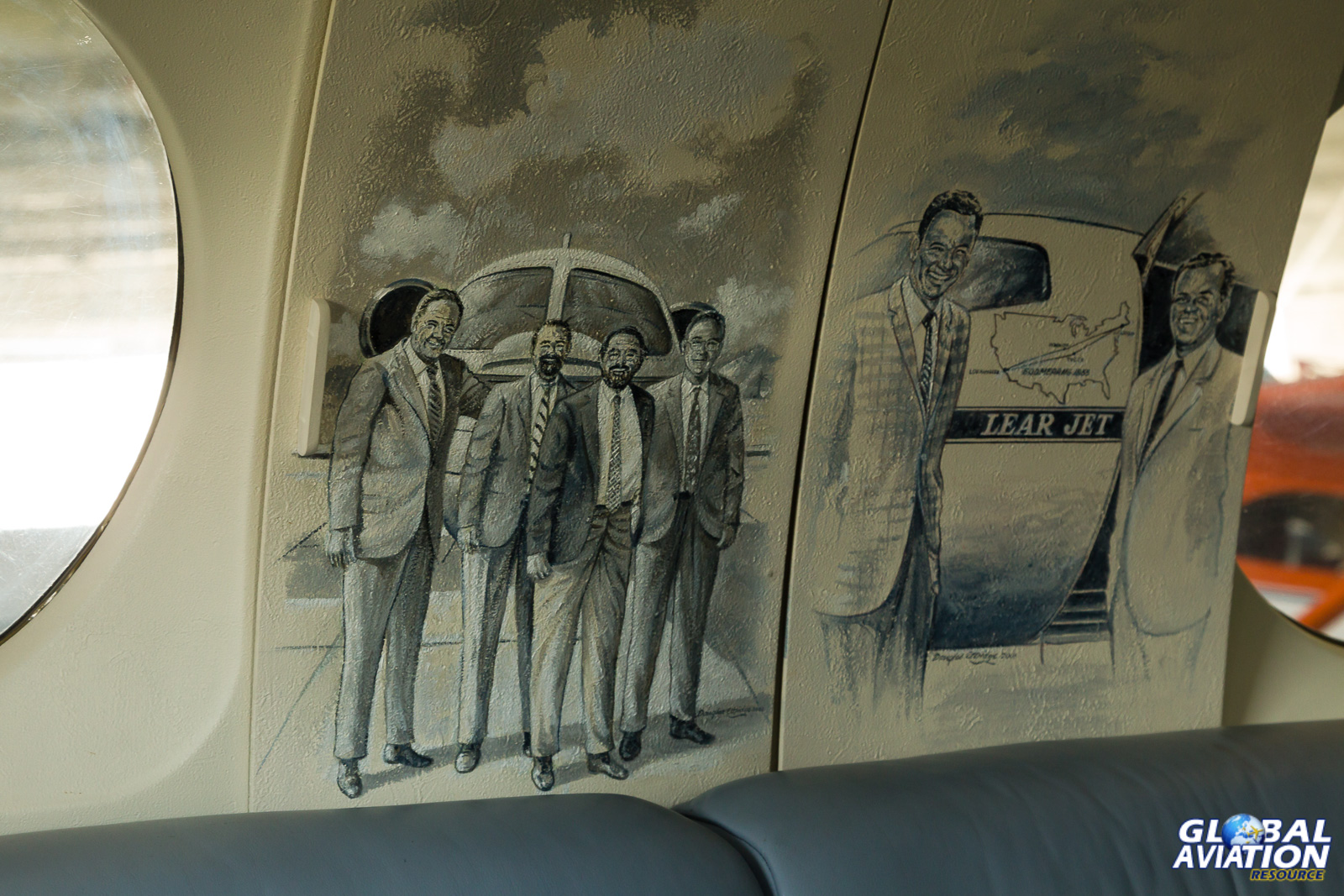
Interior artwork – © Rob Edgcumbe Global Aviation Resource

Clay still has his early jets – © Rob Edgcumbe Global Aviation Resource
The arrival of a Learjet in Los Angeles provided opportunities for a lot of publicity. Getting Hollywood celebrities into the jet gave it a very high profile and having it appear in TV shows also made the brand very familiar across the country. Clay flew all of the names that you would find familiar if you had been a follow of the movie business at that time. One of the Learjets he still owns from that time has the interior decorated with images of the famous people who flew with him including Frank Sinatra and Danny Kaye (who was a partner in the distributorship).
Meanwhile, during a United layover in Reno, Clay came across a notice from the Chamber of Commerce about upcoming air races. He suggested to Allen Paulson that they should look at getting a P-51 to race. As it happened, Paulson had just been offered a P-51 as part trade in on a Cessna 310. They took the deal and bought the P-51 to race. At the time, the aircraft cost them the staggering amount of $7,500. It is hard to imagine getting an airworthy P-51 these days for that amount even adjusted for inflation. (Spare engines were also easily sourced for about $900 each at that time too!) Clay later bought the aircraft from Allen for $12,500 including the spare engines.
They entered the P-51 in all Unlimited Air Races from 1964 to 1972. The races were at venues across the country and provided an opportunity to promote the Learjet business although looking back on it, Clay thinks it was more about having fun. In those days the races were focused on aircraft a lot closer to stock configuration than those you would see racing today. (Clay still has the P-51 and flies it occasionally and it remains in immaculate condition.)
Clay raced the P-51 from 1964 to 1972. He was second or third in each race until 1970 when he won the race at Reno. He also took part in a cross country race from Milwaukee to St Louis. Most people chose to fly low but Clay thought going higher and flying IFR would be an advantage. “I had it in high blower at 61 inches at 30 thousand feet and it trued out at 505mph. The guy in the air traffic centre asked what type of plane it was. I told him it was a P-51 Mustang. He said “Doesn’t it have a propeller? We’re clocking you at 470kts.” I said “Good, I’m in a race!”” The tactic worked and he won the race.
Another race was coming up. It was to be a closed course race at Mojave over a race distance of 1,000 miles. Allen Paulson had recently repossessed some DC-7s from an airline that had failed to make their payments. The race distance was a long run in a P-51 so Clay asked if he could race one of the DC-7s. Allen agreed so they entered a DC-7 in the race.
“We started in 20th position. We ended up in sixth. A lot of people think it was because we were the only ones that went nonstop but that isn’t true. About six people went nonstop. We could have won if I hadn’t been playing around. Probably a good thing we didn’t as it might have been bad for air racing.” They lost by three minutes which, if he had known, he thinks they could have made up. They didn’t use a g meter for the early part of the race. When they did, it knocked 15 seconds off a lap. “When you fly a big airplane, you think you are doing something you shouldn’t be doing. With a g meter, you fly it to the limits.” If they had used it from the start, winning would have been feasible!
In 1968, Bill Lear sold Learjet to Gates Rubber Company. They had a plan that did away with dealerships and moved to a factory direct sales model. Clay and his partners had a 10 year franchise so didn’t have to give up the business but the partners agreed it would suit them better so they all moved on. Clay moved immediately into the charter business. He started out leasing a single Learjet and a year later bought his first aircraft. Within three years he had three jets on the books.
This was the start of the business that continues to this day. The charter business continued to grow and has now moved into management of aircraft owned by other companies. However, before explaining where things are today, there is a side business with the Learjets that Clay developed that has proved to be a passion for him over the years and has made his name familiar to many aviation enthusiasts around the world. Astrovision.
Before Astrovision was created, B-25s were the camera ship of choice for manufacturers filming their aircraft in flight. As jet airliners became the norm, the use of a B-25 as a camera platform became problematic due to the speed differential and the time taken to position the target aircraft for a pass while it was filmed.
Douglas was interested in something that was better suited to shooting the DC-8s they were building. Clay started working with a company called Continental Camera. The VC-10 had a periscope system that had been designed to allow the flight engineer to inspect the engines in flight. A number of the surplus units were purchased and, working with Continental Camera, they came up with an installation for the Learjet.
The basic system consists of a periscope through the roof and one through the floor. They can be panned 360 degrees and tilted while hooked up to a camera (still or motion) to film aircraft in flight. There is a monitor for the pilot to keep visibility of the other aircraft. When not required, the system can be removed and plugs fitted to the aircraft in place of the periscopes. Clay has two aircraft currently in his fleet that can take the installation.
The system allows filming of high performance aircraft at operating speeds. The majority of work is for airline customers that need promotional material. Manufacturers are the next most frequent customers and then there is film work for Hollywood. Many films have involved Clay’s system but the one probably most familiar to aviation enthusiasts will be Top Gun.
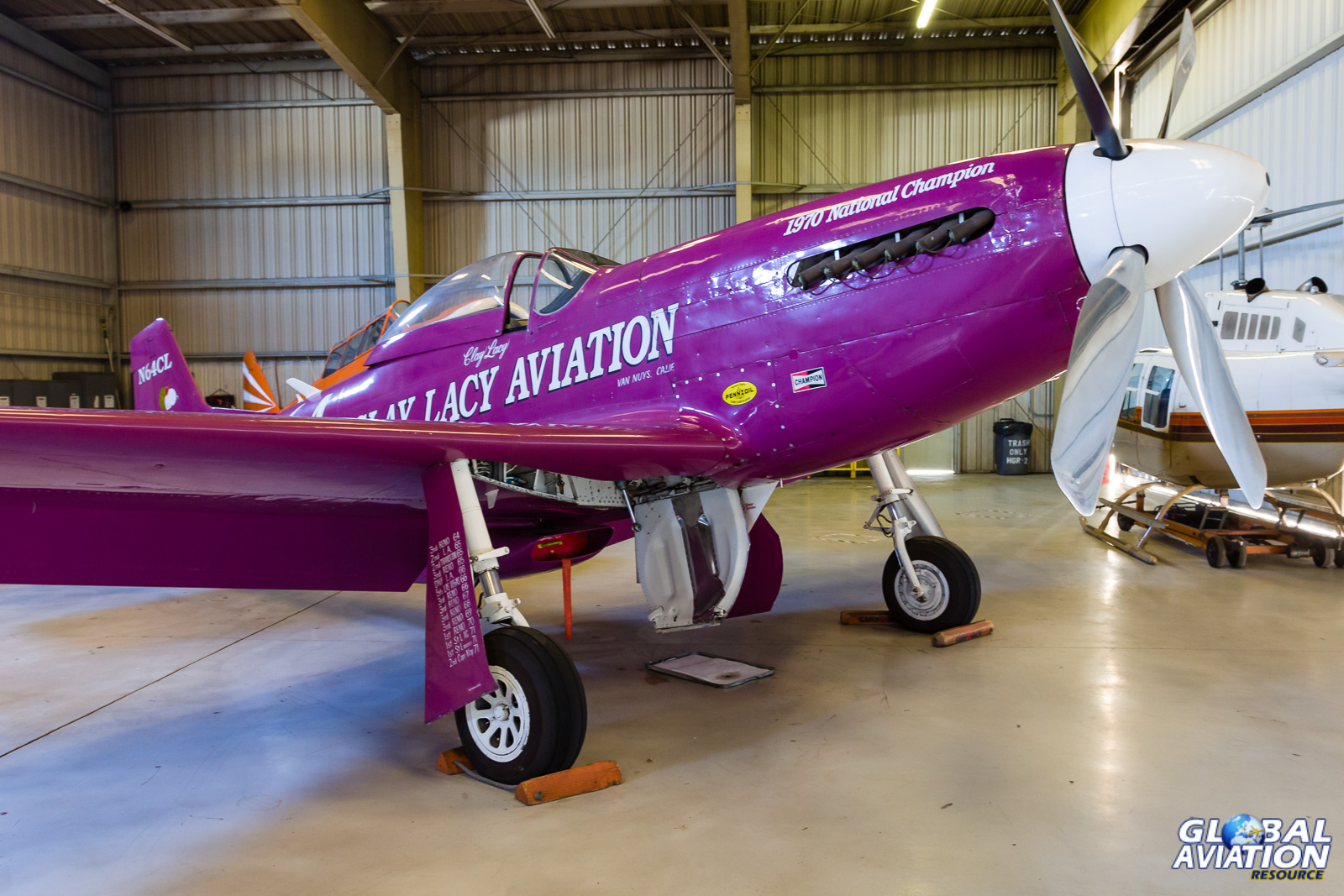
The P-51 that participated in many races – © Rob Edgcumbe Global Aviation Resource

Clay leads in the P-51 – Clay Lacy Collection
The system has evolved over the years and now high definition video is as likely to be used as film. However, all types are taken and it is common to get stills on a flight along with the video. Over 3,000 flights have been made on photo missions and Clay flies over 90% of them himself. For the majority of flights, there are not pilots trained in formation flying in the other aircraft. In these cases, they are given a heading and altitude to fly (usually on autopilot) and Clay flies the camera ship around the target aircraft. There is no zoom capability on the system so what you see is the result of Clay’s positioning of the camera ship.
During all of this time, Clay continued to fly for United Airlines. In his capacity as a pilot there, he still managed to get involved in interesting projects. One of these was a round the world flight in support of an aeronautical program for a university. The trip involved taking a DC-8 from the top of the world to the bottom over the course of 15 days in 1973. They flew over the North Pole and as far as 85 degrees south. That flight, which launched from Sydney and recovered into Auckland included letting down to sea level when down over Antarctica. It flew to every continent except South America. One of the more amazing aspects of the trip is that the whole thing, including hotels, only cost $1,600!
In 1987, he had an even more adventurous trip. He proposed to take a Boeing 747 around the world on a fundraising trip for children’s charities. He proposed the idea to Eddie Carlson, ex-CEO of United Airlines (UAL) and a board member at the time. Carlson took the idea to the UAL board that approved the plan. The chairman was Fred Olson and, when he learned that the effort would raise over $500,00 for children’s charities, was simple and that all United had to do was provide the plane, he said yes.
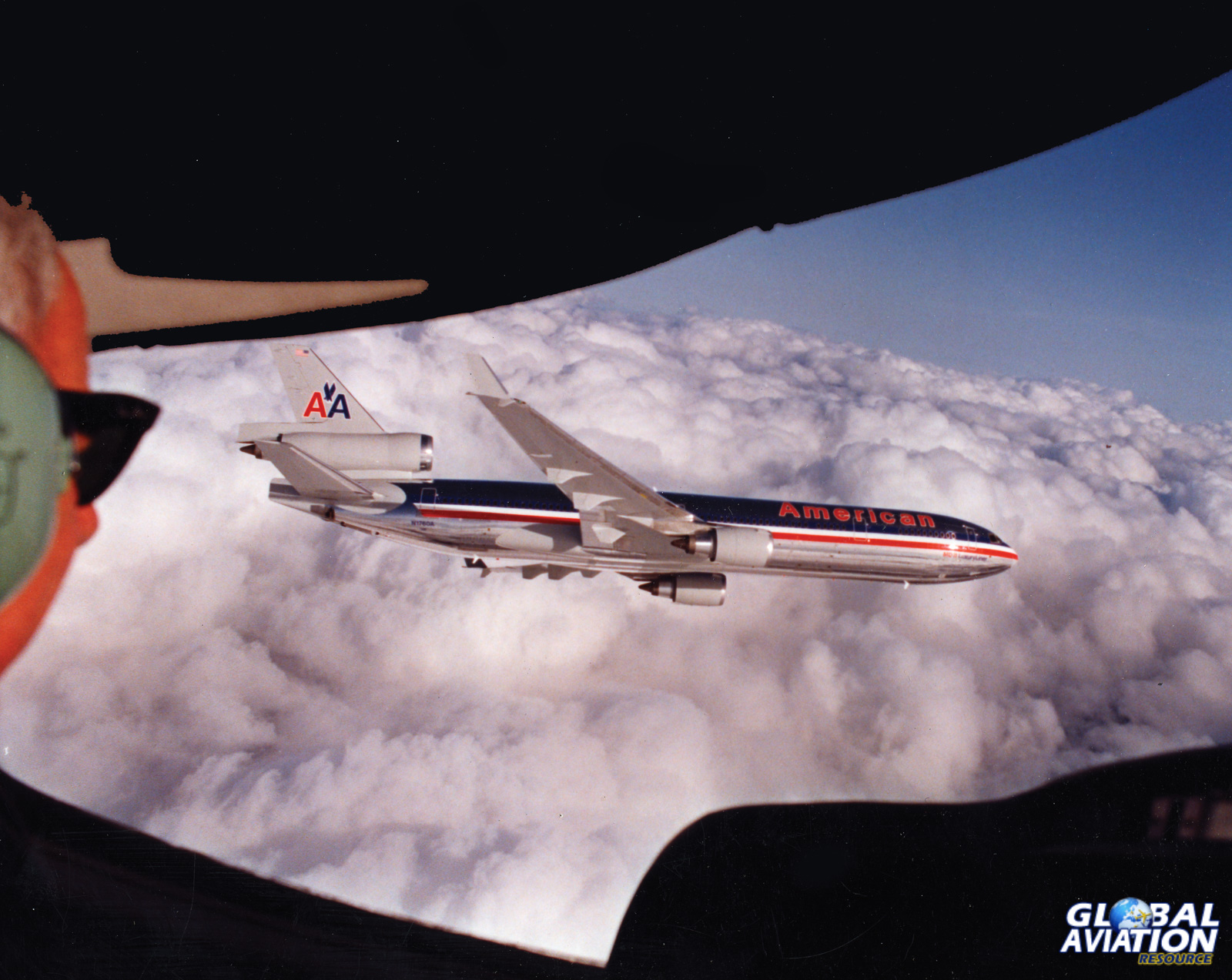
American MD-11 banks away from the photo ship- Clay Lacy Collection

Clay displaying the Lear at the Reno Air Races – © Rob Edgcumbe Global Aviation Resource
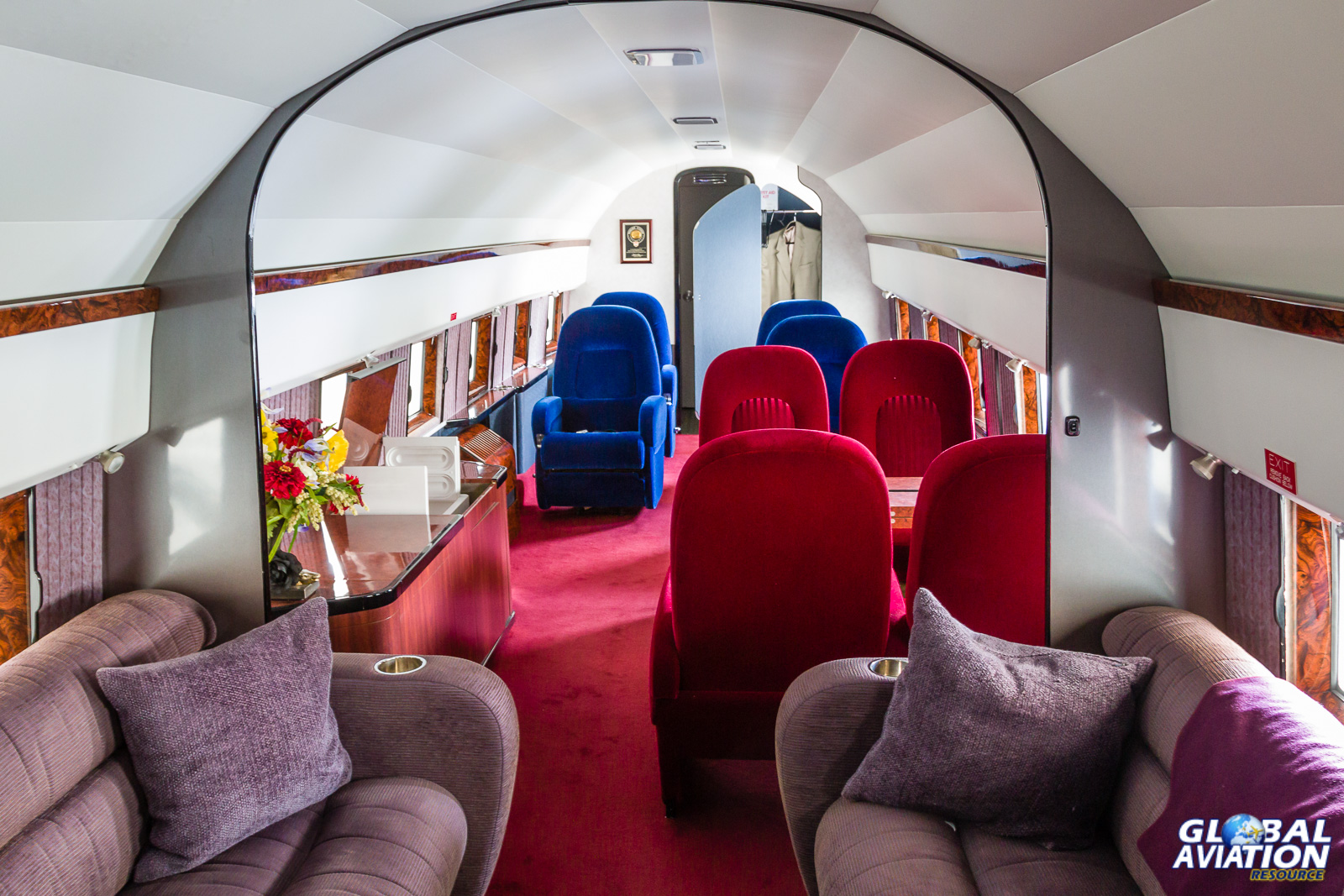
The DC-3’s luxurious interior – © Rob Edgcumbe Global Aviation Resource
The Boeing 747SP that they took around the world was called Friendship One. Clay crewed it with a number of his friends in the United pilot and flight engineer corps. His wife, a flight attendant for United, arranged for the eight attendants for the trip. All crews went along for free. The passenger list included a number of aeronautical notables including Neil Armstrong. The set a new speed record for a round the world trip and, in the process, raised over half a million dollars for the children’s charities involved.
Clay retired from United when he reached the age of 60 which, at that time, was the mandatory retirement age. He actually was 60 at this point, having rectified the records at the FAA as mentioned before! The charter business continued and had developed into something far larger.
For the first ten years of his operation, he had rented a hangar at Van Nuys from which to run the business. Then, in 1981 he built his own facility. This is still the heart of the operation with a number of buildings from which it operates and several hangars on the field. It also includes an interior refurbishment facility across the street. This maintains the company aircraft, provides repair and upgrade facilities for the managed aircraft and has done some third party interior rebuilds up to Boeing 727 sized aircraft.
They currently manage a fleet of about 50 aircraft. Clay discusses the management of other people’s aircraft as a major change in the business in recent years. “The biggest thing in corporate aviation in the last 15 years has been managing aircraft. It used to be that a company would buy an airplane, hire pilots and mechanics and set up a flight department. That is almost a thing of the past. Over half of the jets flying are now managed.”
The owners get the benefits of making use of resources that are shared across multiple airframes. The aircraft are also utilised far more efficiently and this all serves to reduce the cost to the owner. Additionally, Clay believes they provide a safety benefit by managing the pilots that operate the aircraft. They have a better ability to determine whether pilots are capable and suitable for the type of work involved and they make sure they are available when needed.
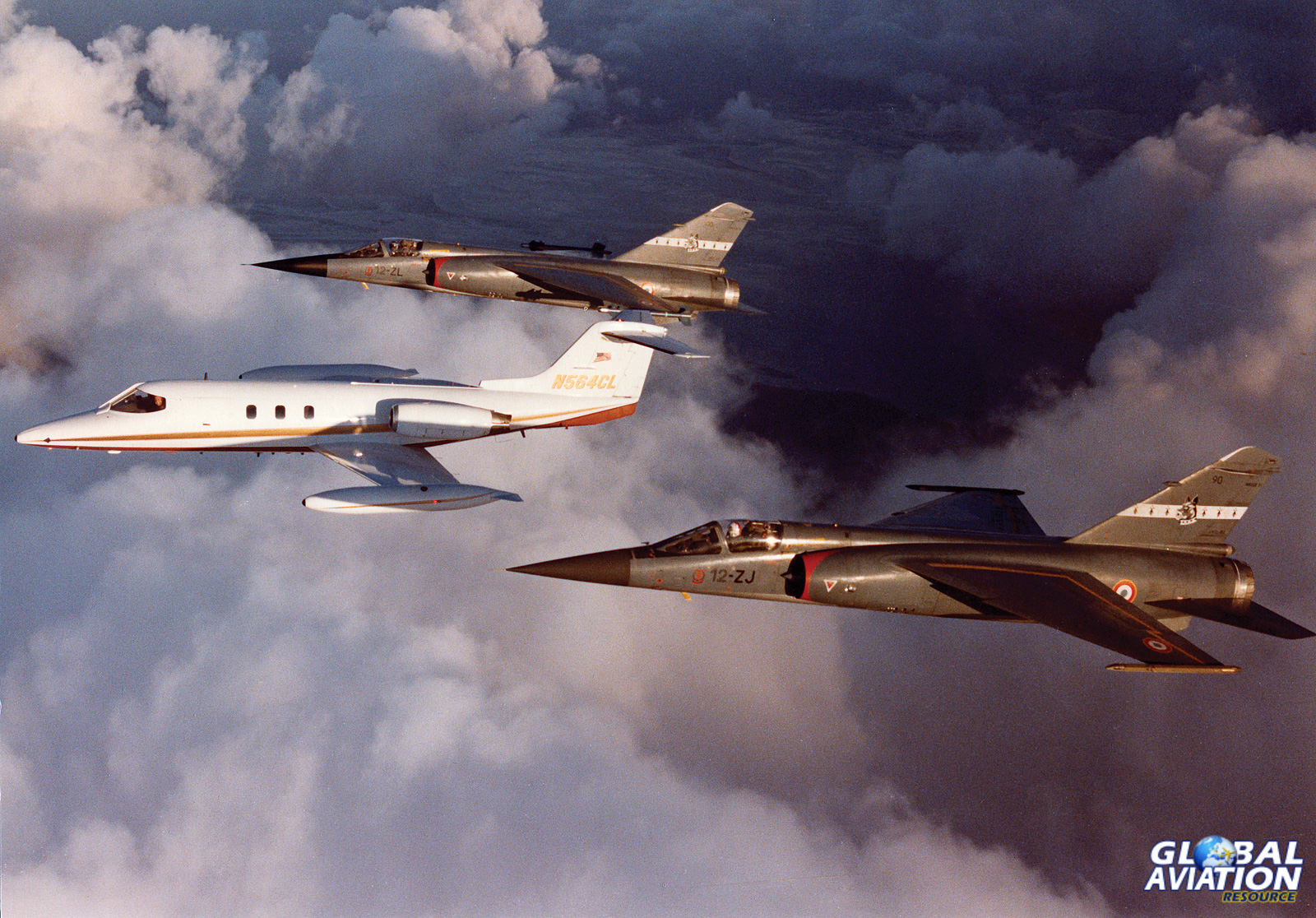
A Lear with a pair of Mirage F-1s- Clay Lacy Collection

Clay Lacy Aviation ramp February 2009- Clay Lacy Collection

The shadow of the Lear over a 777 – Clay Lacy Collection
When questioned as to whether the introduction of fractional ownership programmes has impacted on the charter and management business, Clay actually feels it has helped the business out. “They got a lot of people into aviation. Those people then discovered it was a lot more expensive than they thought and got into chartering or even buying their own airplanes.” All of this has helped to develop the operations of Clay Lacy Aviation.
The fleet is biased towards the larger type of aircraft. About 23 of the current fleet are Gulfstreams but they also have Falcons, Citations, Hawkers and, of course, some of the Learjets. Clay stills owns some Learjet 35s and these continue to be a great charter aircraft. They don’t have the space of a Gulfstream but they get there at the same time!
While Clay has owned about 20 different Learjets over the years, he still has a few and has even recently been displaying one on the air show circuit. The jet is owned by his friend Joe Clark, founder of Aviation Partners and collaborator with Clay over the years on a number of projects including some record breaking flights. This Learjet has been modified with a smoke system and has performed display routines at some shows in the western US. Clay shows off just how nimble an aircraft it is. He also has a number of historic Learjets, not all of which fly. Some will soon be donated to museums around the country.
There are many aircraft that Clay has flown over the years. In his total time of over 53,000 hours, he has been in many types and still owns quite a selection. Apart from Learjets, he has the P-51, a Bell JetRanger, a Pilatus Turbo Porter, a DC-3 with a beautifully restored interior plus a number of other types. All of them still fly. He has also made the first flight of five different aircraft including the Guppy. The test flying is a story in itself that deserves more space than we can provide here.
As Clay puts it, “If I have any claim to fame, I don’t think anyone else has been involved in as many different phases as I have and not just real quick – most of them I was in long enough (or still am) to be a bit of an expert.” I think discussing a possible claim to fame is superfluous. Clay is famous and it isn’t hard to see why.
Through all of this, I have skimmed the surface of his activities. There are so many more tales to be told but I hope this has provided an introduction to a life that has, so far, never been short of fascinating activity. What Clay has yet in store for us, we shall have to wait and see.
Rob Edgcumbe would like to thank Clay Lacy.


